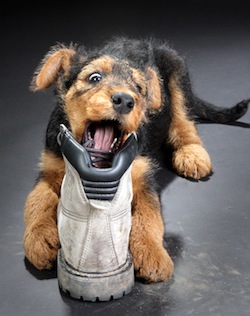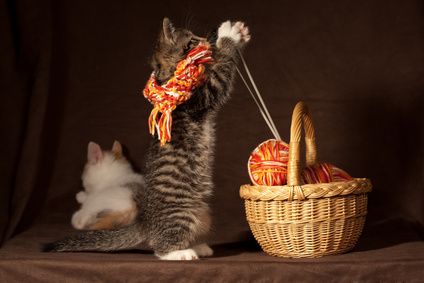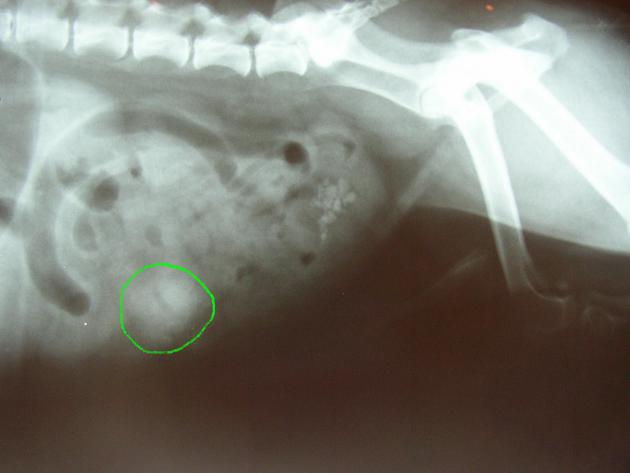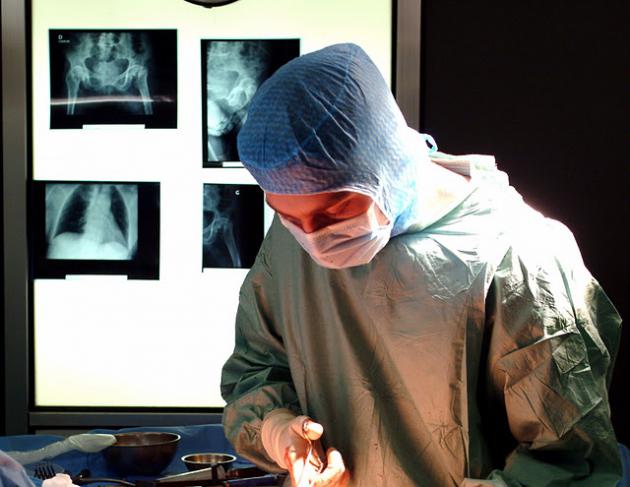Gastrointestinal foreign bodies
 Ingestion of foreign bodies by pets is relatively common. It concerns mostly young animals (often more players than adults) and is common in dogs and ferrets (a little less in the cat).
Ingestion of foreign bodies by pets is relatively common. It concerns mostly young animals (often more players than adults) and is common in dogs and ferrets (a little less in the cat).
These swallowed foreign bodies do sometimes have no impact on the State of health of the animal (especially if they are vomiting shortly after ingestion or if they manage to pass naturally along the digestive tract) but they can also, When they are responsible for obstruction or perforation, very serious consequences, or even result in the death of the animal.
1.THE CAUSES OF ABSORPTION OF FOREIGN BODY
# Foreign bodies can be swallowed by accident during a game:
– The Young Puppies love exploring their environment with all new object met in the hangover.
– Cats love to play with all kinds of long objects (Twine, ball of yarn, curtains…).These games can lead to absorption of a linear foreign body.
– One Rabbit left in freedom will have access to various types of materials, such as carpet or carpet fibers, pieces of paper, carton…
– The behavior of ferret promotes the risk of swallowing foreign bodies: ferrets spend lot of time to chew, shred everything that is left within their reach, including non-edible objects (Twine, fabric, MOP, carpet, pieces of plastic, rubber seals…). In addition, these animals are not able to digest plant material and the diameter of their gut is very small. Anything more than a centimetre in diameter (including food) is therefore likely to cause them occlusion (kibble for dog, pieces of hazelnuts, Cherry kernel, Peanut…)
# A large amount of hair present in the digestive tract of an animal can also behave as a foreign body. This phenomenon can occur:
– in animals with a very marked grooming behavior : Pay particular attention to their toilet rabbits or cats can absorb a great amount of hair licking. These "hairballs" can cause impairment of the transit. These digestive disorders are accented in rodents who drink little and receive a poor diet in cellulose and fresh greenery: the transit is then slowed and dehydrate the hairball in stomach giving birth to very compact clusters called phytobezoars.
– among the parasitized animals ( presence of gale, chips, cheyletiellose…) that snapped up hair scratching and swallowing a large amount.
# Finally, some behavioural disorders can promote the absorption of foreign bodies. This is particularly the case of the animals hyperactive who spend their time to chew all kinds of objects and animals suffering from depression of involution (older dogs who reappear childhood behaviours such as oral exploration: these old animals are recovering to wear muzzle and to eat inedible objects)
2.SYMPTOMS
In some cases, being absorbed by accident will be vomit or pass unhindered in the digestive tract (unusual objects found in the feces of the animal)
Unfortunately, It can also remain blocked in a region of the digestive tract and cause various disorders. They will be variable depending on the type of swallowed object and the area of the digestive tract in which it is located:
– Blocked foreign bodies in the mouth or the pharynx are often easily highlighted. They accompany a gene for feeding and important salivation.
– Located foreign bodies in the stomach are sometimes relatively well tolerated, at least at the beginning of evolution. Carnivores, disorders associated with their presence are those of a chronic gastritis (chronic inflammation of the stomach): the animal eats less well, vomit regularly…In rodents (Rabbit, Chinchilla, Guinea pig, Hamster…), one gastric stasis (slowing of the digestive transit and accumulation of food in the stomach) may be due to the absorption of hairballs, carton, bedding or carpet fragments. The animal then makes small droppings very hard and dry or more boogers at all; He became less bright and loses gradually the appetite.
– When a foreign body comes to stay at the level of the intestines, disorders appear , in general, much more brutally. The symptoms are all the more important that the object is located "at the beginning" intestines: animals in occlusion will become dehydrated very quickly, and their general condition deteriorates sharply. They often refuse all food and frequently present, vomiting. The animal complains when it palpates her belly and turned up in revealing positions of abdominal pain: It remains prostrate, folded on itself and seems to suffer when you want to move or it is placed in the position "of the prior" (It lies on the forelimbs but keeps the records later). Occlusion is accompanied by a transit stop but the animal may still emit feces in the form of bloody diarrhea. If no treatment is started, the animal will suffer considerable dehydration associated with very severe fluid disorders with extremely serious consequences for the organism. In addition, These foreign bodies remained in the gut can cause the death of intestinal tissue or intestinal perforations followed by peritonitis.
A few points to remember…
– Vomiting are very frequent during absorption of foreign body but they are not systematic. The Anatomy of some species does not allow them also to vomit, as is the case for the rabbit and many other rodents. No need, these animals, Search this symptom.
– Occlusion is accompanied by a the transit stop digestive but not necessarily from a total absence of stool. Sometimes, small amounts of stool are still issued in the form of bloody diarrhea.
– Finally, certain kinds of swallowed objects can cause much more crude symptoms. This is the case of the body linear foreigners :
These foreign bodies ( fishing line, wire Garland, trash bag link, a curtain of wire wire…) are sometimes swallowed by cats during a meeting of games. A part of the body of the thread clings to the base of the tongue while the two ends are swallowed. The thread will therefore continue its progression in the digestive tract while remaining stuck, for a party, at the base of the tongue. Symptoms associated with the presence of this foreign body are, initially, much less important than those of a bowel obstruction (the transit is not immediately interrupted) but the consequences of the presence of the wire will be equally serious for the animal: Indeed, the intestines will continue to contract on the "wire" and will either collect around the wire (causing the same symptoms as occlusion), either be sheared off by him (then trigger a bowel perforation, peritonitis…).
During occlusion, all revealing symptoms of the condition are not always necessarily present. Should therefore consult a veterinarian When any fatigue sudden your pet associated with signs of abdominal pain (this as he is a young player animal).
3.DIAGNOSIS OF THE PRESENCE OF A FOREIGN BODY
A precise description disorders that you have observed in your animal (behavior changes, apathy, refusal to eat, vomiting, constipation, refusal to lie…) can help the veterinarian to suspect a foreign body absorption.
Abdominal palpation will often reveal a significant abdominal pain but the diagnosis requires the use of various methods of medical imaging:
– The presence of some foreign body can be suspected or even directly revealed by one radiography simple: dilation of the stomach and the presence of air on an abdominal x-ray of rabbit will be very strongly suspects the presence of phytobezoars while metal objects or bones will be directly visible on the abdomen of a dog radiographic.
Green: foreign body in the abdomen of a dog (It was a piece of rubber)
(the x-ray also revealed the presence of calculations in the bladder)
– Endoscopy can be used to highlight the foreign bodies located in the esophagus or stomach.
– Finally, non-radio-opaque objects (bath mitts, ball bladder, sock…) can be searched by radiography after absorption by the animal a contrast or by Ultrasound.
4.TREATMENT
In some specific cases, medical treatment may be tempted. Including:
– for small and non offensive objects located in the esophagus or stomach.
(vomiting will be then caused the animal to try to make objects or the veterinarian will attempt to remove endoscopically)
– for foreign bodies located towards the end of the digestive tract or to fight against the presence of hairballs with pACE of impact on the general State of the animal.
(An increase in transit is, in this case, sought to eliminate them through natural channels: lubrication of the digestive wall, increase in transit using medication, increase the amount of fibre in the diet with leeks, Zucchini, Endive..)
But most foreign bodies must, after rehydration and stabilization of the general State of the animal, be removed surgically:
– By opening the stomach for foreign body in the stomach (gastrotomy)
– through an opening of the intestines for intestinal foreign bodies (enterotomie).
– Sometimes, a part of the intestine must also be removed if the wall is very aggrieved (enterectomie)
§
Ingestion of an object is not a rare phenomenon in our pets and it is important to quickly to suspect a foreign absorption because the consequences resulting therefrom can be catastrophic in the absence of treatment .
Some measures may reduce the risk of occlusion such as:
– One brushing twice-daily animal hairs to minimize ingestion of hair
– The regular distribution of an specialty veterinarian helping to migration of these furry animals who vomit regularly (paraffin gel oil, eserine…)
– Increased monitoring of young animals or very "players" species such as the ferret
– To prevent any game with objects linear ( links of garbage bags, Rideau's son…)



